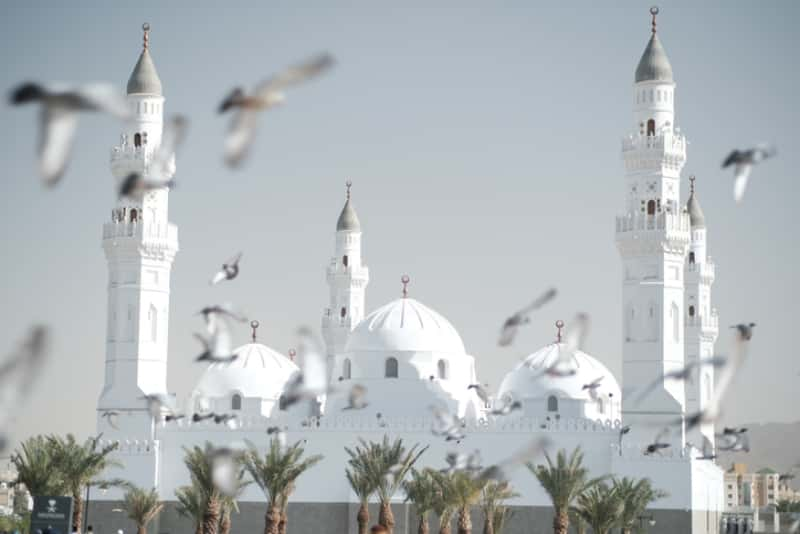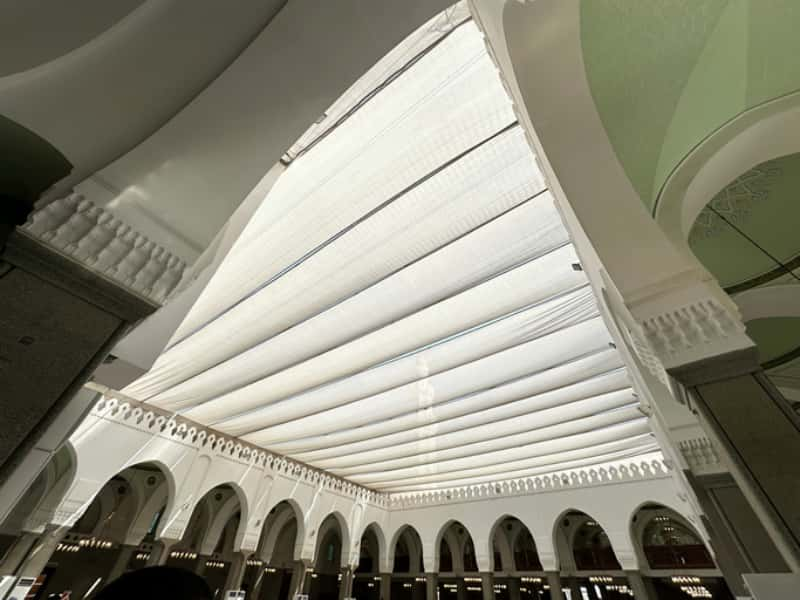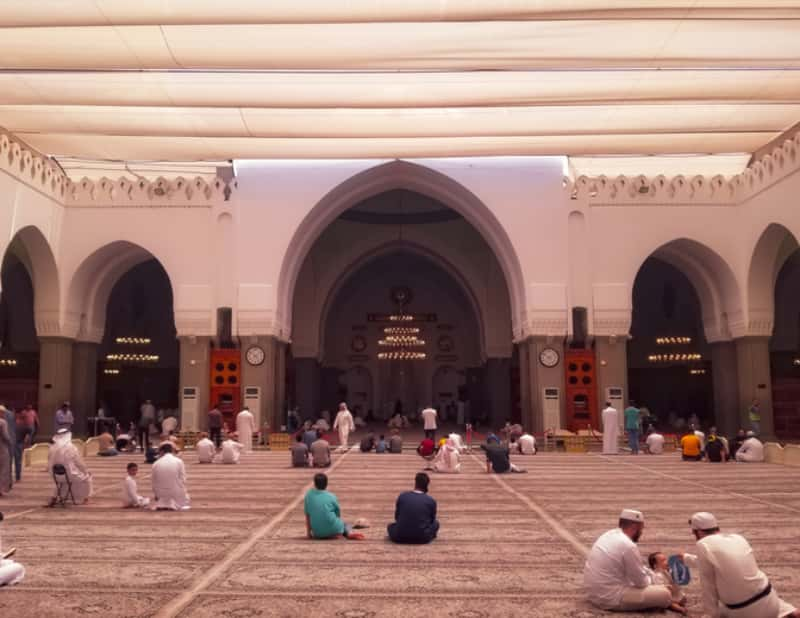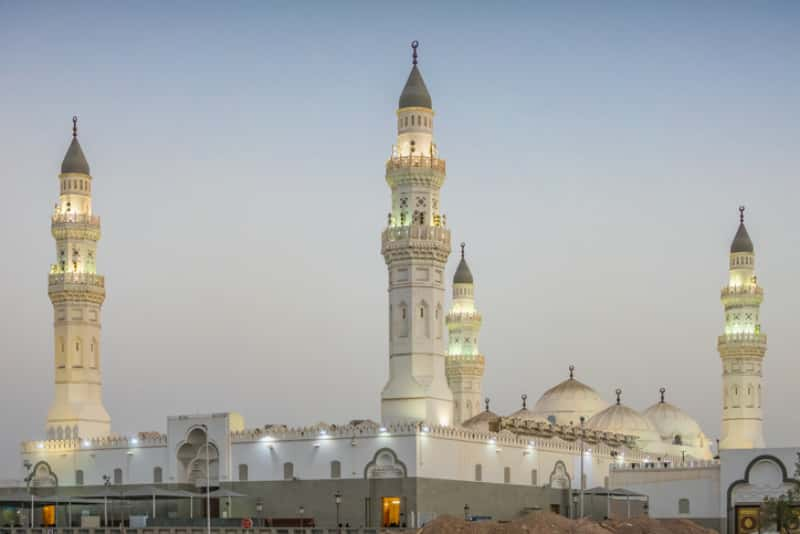Quba Mosque holds the distinguished position as the first mosque built in Islamic history, its foundations laid during Prophet Muhammad's (ﷺ) historic migration from Makkah to Madinah in 622 CE. This sacred edifice gained its extraordinary status when the Prophet placed the first stone of its foundation, initiating a spiritual legacy that flourishes today. Situated roughly 6 kilometers south of Masjid al-Nabawi in Madinah, Quba Mosque enjoys the rare distinction of explicit mention in the Holy Quran (Surah At-Tawbah 9:108), where it is described as "founded on piety"—a divine acknowledgment of its profound spiritual significance within Islam.
Visitors to Quba Mosque today walk the very path once frequented by Prophet Muhammad (ﷺ), who made regular journeys to this sanctuary, particularly on Saturdays, to perform prayers within its blessed confines. The spiritual bounty attached to this site proves remarkably abundant—scholars note that offering merely two units of prayer (rak'ahs) at Quba Mosque equals the reward of completing a minor pilgrimage (Umrah). The mosque's current architectural magnificence emerged following extensive renovations completed in 1986, featuring an impressive array of domes. This expanded structure accommodates more than 30,000 worshippers across its 13,500 square meters of grounds.
The pages that follow unveil the fascinating chronicle of Quba Mosque, tracing its evolution from modest origins to architectural splendor across successive Islamic eras. The narrative further explores the ambitious expansion initiative announced in 2022—a project set to enlarge the mosque's footprint tenfold to 50,000 square meters, thereby boosting its capacity to 66,000 worshippers. These developments ensure Quba Mosque perpetuates its enduring role as a nucleus of worship, community gathering, and Islamic heritage.
The genesis of Quba Mosque intertwines inseparably with a watershed moment in Islamic chronology – the Hijrah (migration) from Makkah to Madinah in 622 CE.
Prophet Muhammad (ﷺ) halted his journey in the modest settlement of Quba while fleeing persecution in Makkah, approximately 6 kilometers south of what would eventually flourish as Madinah. Historical narratives present varying accounts regarding his sojourn duration in Quba. Several sources document a brief 3-day stay, while alternative chronicles suggest an extended period of up to 22 days. Ibn al-Qayyim offers yet another timeline, recording that the Prophet dwelt in Quba for 14 days before resuming his journey to Madinah.
Anticipation gripped the residents of Yathrib (later known as Madinah) during this momentous period. Historical manuscripts reveal how locals would daily venture beyond their palm groves into open fields, scanning the horizon for any sign of the Prophet's arrival. Their vigilant wait concluded when a resident spotted the approaching white-robed travelers and proclaimed with unbridled excitement, "O people of Arabia! What you have been waiting for has arrived!"
Quba Mosque bears the distinctive honor of being Islamic history's inaugural mosque. Authenticated accounts confirm that Prophet Muhammad (ﷺ) personally positioned the foundation's first stone. Certain traditions elaborate further, noting that following the Prophet's placement of the initial stone, his closest companions – Abu Bakr, Umar, and Uthman – each laid subsequent stones in succession.
The Prophet's hands-on participation in the mosque's physical construction reveals remarkable dedication. Al-Tabarani's narration through Al-Shimous Bint Al-Nauman describes witnessing the Prophet carrying stones and rocks upon his back until it visibly bent, with dust clinging to his garments and abdomen. When concerned companions offered assistance, he declined their help, instead encouraging them to shoulder similar burdens.
Historical records present divergent accounts regarding the original site selection. Some narrations identify the location as a mirbad (date-drying area) belonging to the Prophet's host Kulthum, while alternative sources suggest the spot where a woman named Labba had previously tethered her donkey.
The nascent Quba Mosque embodied simplicity – raw bricks formed its walls while palm leaves provided modest roofing. Its orientation initially faced Jerusalem, though scholars believe reconstruction likely occurred following the divine directive changing the qibla (prayer direction) toward the Kaaba in Mecca.
Despite its architectural modesty, this inaugural sanctuary established a vital spiritual nucleus for the fledgling Muslim community. Following its completion, historical documents attest that Prophet Muhammad (ﷺ) maintained a regular practice of visiting the mosque every Saturday, traversing the distance either on foot or astride his camel, to perform prayers within its sacred confines.

Quba Mosque stands today as a testament to fourteen centuries of architectural heritage, its physical form evolving dramatically from a modest prayer space into the magnificent sanctuary now gracing Madinah's landscape.
The mosque's first notable architectural enhancement occurred under the guidance of the third Caliph Uthman ibn Affan. Later, the Umayyad dynasty ushered in an era of significant structural advancements. Between 705-715 CE, Caliph al-Walid I undertook comprehensive reconstruction efforts that substantially elevated the mosque's stature. A truly remarkable milestone occurred during Umar ibn Abd al-Aziz's caliphate (717-720 CE) when Quba Mosque received its first minaret—a distinction worth noting, as this represented the first minaret constructed for any mosque in Islamic history.
Architectural refinements continued in 1044 CE as Abu Ya'la Ahmad ibn Hasan (also called Abu Yali Al-Husayni) introduced a mihrab (prayer niche) to the sacred structure. The subsequent eight decades witnessed additional enhancements, culminating in another significant renovation in 1160 CE under the direction of Jamal al-Din al-Isfahani, a renowned Muslim poet and patron.
Ottoman sultans displayed profound reverence for the Quba Mosque through their patronage of multiple restoration projects. Sultan Suleiman commissioned extensive reconstruction work in 1543, focusing particularly on the minaret and ceiling elements. Following this tradition, Sultan Mustafa II initiated similar renovations to these architectural features in 1699.
The mosque underwent its most substantial Ottoman-era transformations beginning in 1829, with work continuing through the subsequent decade during the reigns of Mahmud II (1808-1839) and Abdülmecid I (1839-1861). These meticulous Ottoman renovations successfully preserved the mosque's historical essence while simultaneously enhancing its architectural splendor.
The establishment of Saudi Arabia heralded a new chapter in the Quba Mosque's architectural story. King Abdulaziz, recognizing the sanctuary's importance, ordered construction of a direct road linking the Prophet's Mosque with Quba Mosque in 1932. King Faisal's reign saw further improvements in 1968, including refurbishment of the exterior walls and extension of the northern portico to accommodate a dedicated entrance for female worshippers.
The most ambitious reconstruction effort commenced in 1984 under King Fahd's direction. Egyptian architect Abdel-Wahed El-Wakil received the commission to design an expanded structure capable of hosting 20,000 worshippers simultaneously. Upon completion in 1986, this architectural masterpiece had transformed the mosque from its traditional square footprint to a rectangular layout, adorned with four towering minarets and 56 elegant domes.
Crown Prince Mohammed bin Salman announced in 2022 the King Salman Project—the most extensive expansion in the mosque's storied history. This audacious initiative aims to increase the mosque's area tenfold to 50,000 square meters, dramatically expanding its capacity to accommodate 66,000 worshippers.

Quba Mosque transcends its historical foundations and architectural splendor to occupy a position of profound spiritual importance within Islamic tradition. Muslim hearts worldwide revere this sanctuary due to its divine endorsement and exceptional religious merits.
Quba Mosque bears the remarkable distinction of explicit mention within the Holy Quran itself. Surah At-Tawbah presents a divine contrast between a mosque constructed by hypocrites (Masjid al-Dirar) and Quba Mosque, which Allah describes as founded upon genuine piety:
"Do not [O Prophet] ever pray in it. Certainly, a mosque founded on righteousness from the first day is more worthy of your prayers. In it are men who love to be purified. And Allah loves those who purify themselves." (Quran 9:108)
This sacred verse firmly establishes Quba Mosque within the Quranic text, emphasizing its foundation upon taqwa (God-consciousness and righteousness) from its earliest moments. Islamic scholars throughout history have recognized this divine acknowledgment as conclusive evidence of the mosque's exceptional spiritual standing.
Prayer offered within the Quba Mosque carries an extraordinary spiritual bounty. Prophet Muhammad (ﷺ) himself highlighted these rewards through numerous authenticated traditions:
"Whoever purifies himself in his house, then comes to the mosque of Quba and prays there, he will have a reward like that for 'Umrah." (Narrated by Ahmad, al-Nasaa'i, Ibn Maajah, and al-Haakim)
This astonishing spiritual incentive—equating mere prayer at Quba Mosque with the complete reward of Umrah (minor pilgrimage)—continues drawing countless Muslims to this blessed sanctuary across centuries.
The
Despite his multitude of responsibilities leading the nascent Muslim community, Prophet Muhammad (ﷺ) maintained a steadfast practice of visiting Quba Mosque regularly. Multiple authentic sources record:
"The Prophet (ﷺ) used to come to Quba' riding and walking." (Al-Bukhari and Muslim)
Additional narrations specify: "and he would pray two rak'ahs there."
Ibn 'Umar further documents the Prophet's habit of visiting Quba Mosque every Saturday, either mounted or on foot. This established pattern became tradition among many companions, with Ibn 'Umar himself continuing this practice faithfully after the Prophet's passing.
The Prophet's unwavering commitment to regular visits underscores Quba Mosque's spiritual significance, effectively establishing it as a sanctuary of worship second in reverence only to the two Holy Mosques of Makkah and Madinah.

Today's magnificent Quba Mosque stands as a living testament to centuries of reverence and continuous development, drawing millions of faithful visitors yearly to its hallowed grounds.
The contemporary Quba Mosque emerges from a comprehensive reconstruction completed in 1986 under King Fahd bin Abdulaziz. Egyptian architect Abdel-Wahed El-Wakil crafted the structure with a rectangular layout hosting a central courtyard accessible from all entrances. This architectural masterpiece boasts four minarets and 56 domes, with six large domes spanning twelve meters in diameter.
Architectural purists note the mosque's adherence to traditional methodologies in both construction and design elements. Unlike typical contemporary structures, Quba Mosque primarily utilizes brick for both exterior aesthetics and structural integrity, limiting concrete application to foundations and platforms. The central prayer hall connects seamlessly to residential quarters, administrative offices, ablution facilities, commercial shops, and a scholarly library.
Crown Prince Mohammed bin Salman unveiled plans in 2022 for the most ambitious expansion in Quba Mosque's storied history—King Salman's Project—set to increase the mosque's footprint tenfold from 5,035 to 50,000 square meters, dramatically elevating worship capacity to 66,000 faithful.
Quba Mosque currently welcomes approximately 20,000 worshippers. The sanctuary offers exceptional amenities, including:
Female worshippers benefit from a dedicated prayer space occupying the northern section across two floors, accommodating approximately 7,000 women.
Statistical records reveal that over 19 million worshippers have visited Quba Mosque as of 2024. Beyond its primary function as a sacred house of worship, the mosque flourishes as a vibrant center for Islamic education, offering diverse programs teaching Quranic studies and Islamic values to both children and adults.
The innovative "Quba Front Project," integrated within the City Humanization Program, features a three-kilometer pilgrimage pathway extending from Quba Mosque to the Prophet's Mosque, complete with pedestrian facilities, residential towers, hospitality establishments, and commercial zones. This thoughtful development enhances visitor experience while preserving Madinah's distinctive urban character.
For pilgrims undertaking Saudi Arabia tours, Quba Mosque represents an essential spiritual milestone, simultaneously contributing to the local economy while fostering global Islamic unity.
Quba Mosque manifests as an enduring emblem of Islamic heritage and spirituality through the ages. Spanning over fourteen centuries, this hallowed sanctuary has metamorphosed from its rudimentary structure of raw bricks and palm fronds to the magnificent edifice that graces Madinah today. Despite its once modest dimensions, the spiritual magnitude of this mosque has remained constant since the blessed moment Prophet Muhammad (ﷺ) positioned its first foundation stone during the pivotal Hijrah journey.
Divine acknowledgment of the Quba Mosque in the Holy Quran as "founded on righteousness" bestows upon it an elevated status among faithful Muslims worldwide. This celestial recognition draws millions of pilgrims annually to its sacred precincts, each seeking the blessed reward, equivalent to an Umrah, promised for offering just two rak'ahs of prayer within its hallowed walls.
Every architectural enhancement throughout history—from the inaugural minaret erected during the Umayyad dynasty to the expansive developments under Saudi stewardship—stands as testimony to the profound veneration successive generations have accorded this sacred site. The forthcoming King Salman Project represents this continuing legacy, poised to transform the mosque into a substantially larger spiritual haven with capacity for 66,000 worshippers praying in unison.
Visitors to Masjid Quba today traverse the very path Prophet Muhammad (ﷺ) journeyed weekly from Madinah, forging a living link to Islam's earliest days rather than merely encountering a historical monument. Quba Mosque thus persists in fulfilling its original sacred purpose—serving as a sanctuary for devotional worship, community assembly, and spiritual rejuvenation, truly embodying Islamic continuity across fourteen centuries of faith.
Q1. What makes the Quba Mosque unique in Islamic history?
Quba Mosque is the first mosque ever built in Islam, established by the Prophet Muhammad during his migration from Makkah to Madinah in 622 CE. It's mentioned in the Quran as being "founded on piety" and holds immense spiritual significance for Muslims worldwide.
Q2. What rewards are associated with praying at Quba Mosque?
According to Islamic tradition, performing two units of prayer (rak'ahs) at Quba Mosque is equivalent to completing a minor pilgrimage (Umrah). This spiritual incentive continues to inspire countless Muslims to visit the mosque.
Q3. How has the Quba Mosque evolved architecturally over time?
From its humble beginnings of raw bricks and palm leaves, the Quba Mosque has undergone numerous renovations and expansions throughout Islamic history. Today, it features four minarets and 56 domes, accommodating over 20,000 worshippers. A new expansion project aims to increase its capacity to 66,000.
Q4. What is the proper etiquette for visiting the Quba Mosque?
Visitors should perform ablution (wudhu) before entering the mosque. It's customary to enter with the right foot first while reciting a supplication. Once inside, visitors are encouraged to offer two rak'ahs of prayer to gain the associated spiritual rewards.
Q5. How does the Quba Mosque contribute to the local community and religious tourism?
Beyond being a place of worship, Quba Mosque serves as a hub for Islamic education and community gatherings. It's an essential stop for pilgrims and tourists, contributing to both the local economy and global Islamic unity. The mosque also features modern facilities to enhance the visitor experience, including dedicated areas for women and provisions for elderly and disabled visitors.
Experience the spirituality and history of Quba Mosque, the first mosque in Islam, during your Saudi trips. Discover the rewards of prayer in this sacred Madinah site. Plan your journey now!

Find Related Tours


© Copyright 2024 Go Saudi Arabia Trips. All Rights Reserved.